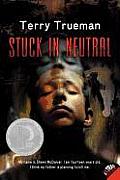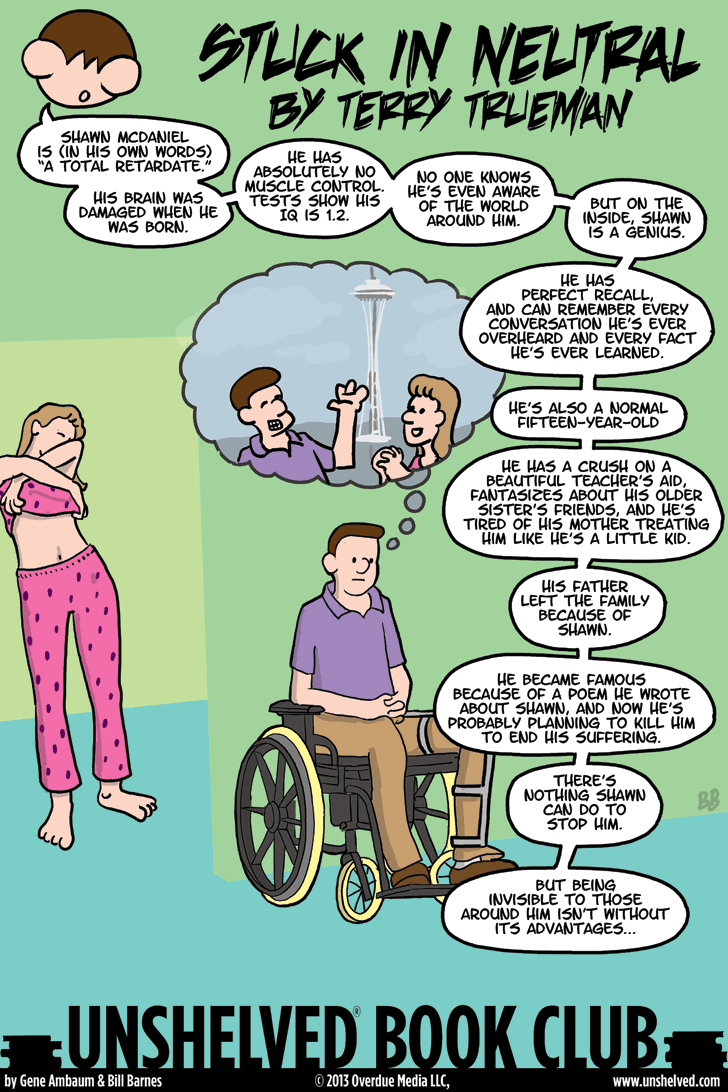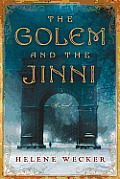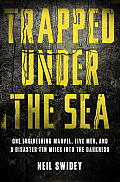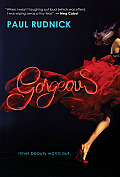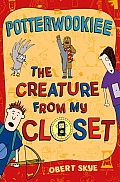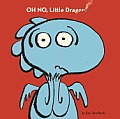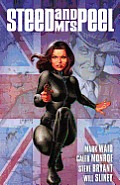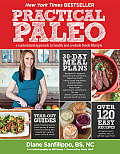Link to this review in the form of a comic strip by geneambaum tagged coming of age
Link to this review by flemtastic tagged paranormal • romance • historical fiction
Chava awoke in a pine box while on a ship, crossing the ocean to New York with her master, the man who commissioned her. A golem made of clay and brought to consciousness by a single word from a powerful, old world magician, she lived only to serve and satisfy the desires of her master. But when he dies during the crossing, Chava must learn to blend in with mankind lest people call for her destruction.
Ahmad, a Jinni, woke up on the floor of a metalsmith’s shop, naked save for an iron band on his wrist. He had no memory of how he had been captured. Unable to change his form back to a being of elemental fire because of the bracelet, he makes his way as an apprentice metalsmith.
Both struggle to appear human and keep their true natures secret, but living in 1899 in New York City, conditions are crowded and tight. Then they accidentally meet, and their differences from other humans and each other draw them together.
Why I picked it up: I heard about this unusual book that juxtaposes Jewish mythology and Arab mythology in an NPR review and immediately added it to my library hold list.
Why I finished it: While the two main characters have magic and decidedly non-human beginnings, that is never the focus of the book. Instead it is about what it means to be human, and whether Chava and Ahmad can get there. There is an undercurrent of evil and foreboding that takes over the last quarter of the book, when the golem’s creator comes seeking her in New York.
It’s perfect for: Stanislav, because it has an old-world European feel. He would love the everyday details of Jewish life in the New York tenements where Ahmad and Chava live, like the descriptions of the raisin challah that Chava makes at the bakery where she works.
Link to this review by flemtastic tagged nonfiction
In the 1980s Boston had released so much sewage into Boston Harbor that the sludge on the bottom was called “black mayonnaise.” The solution was the nine-and-a-half mile long Deer Island Undersea Outflow Tunnel Project. Swidey gives background on the whole endeavor, but focuses specifically on a team of men sent in to complete the tunnel who had to pull the caps off the fifty-five risers that would allow treated waste to diffuse into the ocean. (The caps were put in place during construction to protect workers from a catastrophic flood that might cause ocean water to enter through the risers, filling the tunnel and drowning everyone.) Divers were hired even though they weren’t working in scuba gear because the work had to be done in dark tunnels with very low oxygen levels. The divers were trained, special equipment bought and delivered, then the work began despite voiced concerns about the plan. Tragedy struck soon afterward when two men died of asphyxiation. Then the finger-pointing and court trials started.
Why I picked it up: The book jacket described men doing hard, dirty, dangerous work in a lightless tunnel that ran underwater for over nine miles. I was hooked!
Why I finished it: The decisions required for a large civic project are astonishing. For example, the fifteen million dollar boring machine that made the tunnel could not be backed out, so it was buried under the sea in a grave it dug for itself. The expensive liquid oxygen mixers that the men depended on for breathable air in the tunnel was not initially designed for humans, but was instead created for packaging burritos to extend their shelf life. Also, the special machines that provided oxygen so that Humvees could run in the tunnels were not provided to the divers, leading the prosecutor to claim that the contractor cared more about the vehicles running than the divers’ breathing. Lastly, the survivors of the tragedy all suffered in various degrees from PTSD, which Swidey covers in great detail, providing a human component to an otherwise engineering-heavy book.
It’s perfect for: Jonathan, who would be captivated by the human drama of the divers stuck in the tunnel below the crushing weight of the ocean as their oxygen failed. He’d also be fascinated that the men who built this tunnel understood the general rule of thumb, that one man would die in an accident for each mile of the tunnel.
Link to this review by jana tagged coming of age
Becky lives in East Trawely, MO with her obese mother. Before her mother dies, she tells Becky to believe in magic and say yes to whatever happens to her next. Going through her mom’s things she finds a box that says “Tom Kelly.” Inside there is a phone number. She calls the number and is offered money and a plane ticket to New York. Once there, Tom Kelly says he will make her three dresses — one red, one white, and one black — and turn her into the most beautiful woman in the world. The only condition is that she must fall in love and get married in one year.
Why I picked it up: I was cleaning up a pile of books in Bill’s office and the red dress on the cover of this one caught my eye.
Why I finished it: I loved Rocher, Becky’s best friend. She was always humorous, straight to the point, and brought Becky down from the clouds and spurred her to action as needed. Plus Rocher’s temper and need to speak her mind led to some action-packed fight scenes, like when she and Becky were invited to Ascot for Ladies Day and get into in a cursing, hair-pulling, tumble-on-the-ground fight.
It’s perfect for: Marcieanna, my niece, because we always go shopping together and our favorite thing to do is try on fancy dresses. (She’s already the most beautiful woman in the world.)
Link to this review by geneambaum tagged chapter book • fantasy • humor
Robert has several problems: his obnoxious sister, his neighbor Janae (she’s not interested in him), and the school bully, Wilt. There’s also the fact that he has to keep writing stuff down to record what’s going on with his closet. A small, hairy creature in glasses, a scarf, and a school uniform who is equal parts Harry Potter and Chewbacca just emerged from it. Robert calls him Hairy, and they become fast friends. Now Robert has to keep Hairy secret while he keeps him safe from his buddies, owls, and his little brother.
Why I picked it up: I grabbed a copy after watching Skye and other authors compete against librarians in the Library Family Feud at BEA in 2013. (The luscious Chris Vaccari hosted.)
Why I finished it: It was a quick, fun, bedtime readaloud, particularly when I tried to make these sounds. My daughter and I loved the multitude of mixed-up Harry Potter and Star Wars references. Potterwookiee’s first line: “I’m looking for platform D-2.” Nice.
Bonus: My kid didn’t dare ignore me or fall asleep because she had to keep an eye on Skye’s cartoons and drawings — there’s one on nearly every page.
It’s perfect for: Marley, who will like that Robert wants to try out for his favorite cooking show, Average Chef, and who will understand Robert’s aggravation that his mom keeps insisting he put his little brother on his team.
Link to this review by silver tagged picture book
Little Dragon has a little spark in his heart which comes out and burns things when he huffs and puffs. But oh no! One day he loses it. Will mama still love Little Dragon?
Why I picked it up: Little Dragon looked really scared and sad on the cover.
Why I finished it: The simplicity of drawings and the high-contrast colors really captured my attention, and then the brilliant, photo-realistic flames seemed to leap off the pages at me.
It’s perfect for: Brandon, who recently had his second son. Erik, his first, is a bit nervous because he thinks his younger brother took all his parents’ love. I think that reading this book together will make Erik feel better.
Link to this review by emilyreads tagged historical fiction • coming of age
In the blissed-out 1970s, six teenagers meet at Spirit-of-the-Woods, a camp for artistic geniuses of all sorts: gorgeous Ash, nebbish Ethan, dreamy Jonah, bad boy Goodman, drama queen Cathy, and Jules, an outsider. Over the course of thirty years, their lives intersect, mutate, fall apart, and are rebuilt. Real-life events are casually but skillfully interspersed into the narrative — the Preppy Murder of the 1980s, the early years of AIDS, the rise of investment banking, the Internet bubble(s), 9/11. The true story lies in the relationships among the main characters, particularly the Jules/Ash/Ethan triangle, forged in the limitless potential of youth and burnished by the vagaries of real life.
Why I picked it up: I’d never read Wolitzer, but this plot was compelling: Jules’s status as the impostor among geniuses was totally how I felt in college.
Why I finished it: Despite my best efforts to hate them (or worse, to be indifferent), I liked these characters. I was pleasantly surprised that Jules’s story wasn’t a simple tale of envy or bitterness: Wolitzer created a world in which each character is both blessed and flawed, so I couldn’t root for one against the other.
It’s perfect for: My college roommate, Alice, went to a camp for smart kids in high school and had a similar experience, yet managed to turn out normal and kind and quite successful. I wonder how many of her peers she would see in these wounded, angelic, golden-boy, and insecure characters.
Link to this review by geneambaum tagged mystery • graphic novel
A new The Avengers adventure set in 1965 starring Steed and Emma Peel. They face down the Hellfire Club with Steed’s hard bowler hat, bulletproof umbrella, and his ability to dowse under rubble for a bottle of wine when needed.
Contains material published in Steed and Mrs. Peel #0 - #3.
Why I picked it up: Mrs. Peel. Wow.
Why I finished it: The witty, deadpan repartee between the two characters is just as fun as it was in the original TV show. I don’t normally go in for fan service, but Steed’s outfits pulled me through, too.
It’s perfect for: My daughter. I’m always on the lookout for heroes for her to emulate like Buffy, Rogue, Hellboy, and Teen Titans Go’s Raven. I’ll add Emma Peel to the list since she plays chess, solves mysteries, and can take down several armed men without breaking a sweat.
Link to this review by saracole tagged cookbook • nonfiction
Practical Paleo is a comprehensive, one-stop volume for understanding the whys and hows of using the paleo diet to heal our bodies and maintain optimal health. Sanfilippo also addresses the criticisms of the “lifestyle” in a simple, scientific manner. Includes tips, recipes, and beautiful color pictures that make me hungry.
Why I picked it up: Two words — pumpkin pancakes. While traveling in Ecuador, I met some other American foodies who were raving about Sanfilippo’s recipe. As with most food fads, paleo cookbooks are often written by people committed to the nutritional theory but not necessarily great cooks. So when people rave about paleo recipes, I listen. (Once home, I found the recipe on the internet. My whole family loved it (even my picky twelve-year-old son), so I immediately ordered the book.)
Why I finished it: I’m really enjoying the creative recipes — there is plenty beyond the simple meat and vegetable dishes that often fill paleo cookbooks, though basics are covered, too. Big favorites in my house right now are a non-grain breakfast porridge that has both an appealing texture and flavor (it’s made with nut butter, shredded coconut and coconut milk), hummus made from cauliflower instead of beans, and, of course, the pancakes. Next on my list of dishes to try: roasted marrow bones and stuffed cabbage rolls with tomato cranberry sauce.
It’s perfect for: Our childcare maven, Celeste, who has already taken copious notes from the healing guides and associated thirty-day meal plans at the beginning of the book. In fact, I think she’s hand-copied the digestive health, heart health, and athletic performance sections with her mother, her college-age daughter, and herself in mind.
